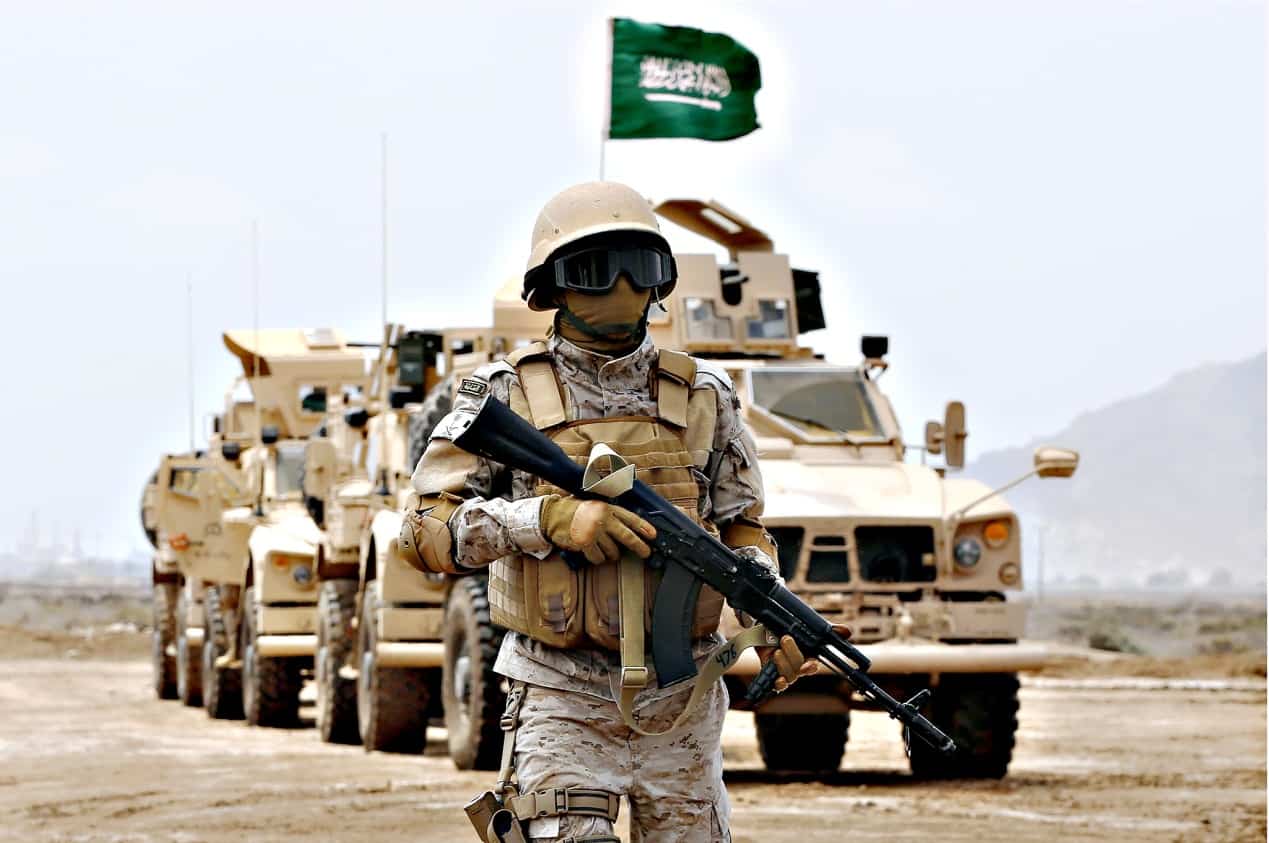Localization of Saudi military industries … Turning a Dream into Reality

Since the 25th of April 2016, the Kingdom of Saudi Arabia has been experiencing a wide-ranging economic and social movement after the Custodian of the Two Holy Mosques King Salman bin Abdulaziz launched: “The Kingdom’s Vision 2030” as the largest economic and social plan aimed at restructuring the Saudi national economy.
The localization of military industries represented a major pillar within those plans, as the Kingdom realized that the positive impact of this localization is not limited to just reducing military spending, in which the Kingdom occupies an advanced position as it occupies 3rd place globally in 2015 and the fourth in 2016 according to the estimates of the International Institute for Research Peace in Stockholm (SIPRI).
There are a large number of goals that the localization process achieves, including:
– Achieving the requirements of Saudi national security by providing all the needs of the Saudi armed forces at any time without relying on the outside, which represents a deterrent to any attempt to prejudice the security and stability of the Kingdom or threaten its interests.
– Maximizing the utilization of local raw materials used in these industries and the resulting economic returns.
– Facing one of the most prominent societal problems, which is the problem of providing more job opportunities for Saudi youth, as these industries would provide thousands of job opportunities.
– Contributing to the Kingdom’s GDP by about SAR 14 billion with the possibility of exporting to countries around the world and the consequent realization of additional resources for the general budget.
Hence, the vision aimed to localize more than (50 percent) of military spending by 2030, starting to work on developing some less complex industries such as spare parts, armored vehicles, and ammunition.
All this by injecting more direct investments into this sector or building strategic partnerships with leading companies, to transfer knowledge and technology and localize expertise in the fields of manufacturing, maintenance, research, and development, while working to establish specialized and integrated industrial complexes.
To achieve this, it required building national institutions that will bear the burden of this responsibility and work to ensure their success, which has already been achieved through structural work on two main pillars:-
First: The establishment of the General Authority for Military Industries… as an important tributary in the localization of industry
The General Authority for Military Industries was established by a decision of the Saudi Council of Ministers issued in August 2017.
The step aims to enhance the capabilities of national military industrialization, localize this sector, and making it an important tributary to the national economy by providing job opportunities for Saudi youth, and advancing development by enhancing non-oil revenues.
The authority is the legislator for the military industries sector in the Kingdom, and is responsible for its development and monitoring of its performance, through achieving 5 main national priorities.
These priorities are: raising military readiness, enhancing strategic independence, enhancing joint operation between all security and military authorities, developing a sustainable local military industries sector, and raising transparency and spending efficiency.
For the authority to achieve its vital system of priorities, the decision to establish it specified its competencies in the following:
Suggesting strategies, rules, and regulations related to the military industries sector and its complementary industries, and managing military procurement operations, bearing in mind that priority is given to Saudi companies following specific controls set by the authority.
The authority also manages and develops the economic balance program concerning the military industries sector and its complementary industries, and negotiates with foreign companies to transfer technology and increase local content, in addition to managing all research and development operations in the sector, including the allocation of research and development budgets and technology transfer.
The authority also coordinates with the relevant authorities to align the outputs of technical education and training with the needs of the sector, work to attract technical competencies to it, set incentives for its development, support local manufacturers, and support the export of local military products.
To ensure that the authority performs its national role, the decision to establish it organized its management mechanism by forming a board of directors headed by the Deputy Prime Minister, with the membership of the Minister of Energy, Industry and Mineral Resources, the Minister of Finance, the Minister of Trade and Investment, and the Chairman of the Board of Directors of the Saudi Military Industries Company.
The authority’s work is based on three main pillars: industry, military procurement, and research, the authority organized some workshops with the presence and participation of local investors in the military industries sector to discuss ways to develop and enhance exports through long-term planning for military procurement.
Since September 8, 2019, the authority has started receiving requests for issuing licenses to engage in military industries activities for companies operating in the sector.
The licenses granted were concentrated in three types: military manufacturing licenses, licenses to provide military services, and licenses to supply military products or services.
The number of registered users through the industrial licensing portal reached 180 users, with a total number of applications for licenses for manufacturing and services, which reached 95.
In November 2019 and through a press conference, the authority handed over the first set of permits to many companies, submitted by them: the Saudi Military Industries Company, the Advanced Electronics Company, the Saudi Advanced Technologies Company, and the Sondos Advanced Company for Industry.
Second: The establishment of the Saudi Military Industries Company… a focal point in the localization process
The Saudi Company for Military Industries, known simply as “SAMI”, was established as a national entity on May 17, 2017.
It is concerned with developing and supporting the military industries in the Kingdom of Saudi Arabia and enhancing its self-sufficiency, in line with the Kingdom’s Vision 2030, which aims to localize 50 percent of the Kingdom’s spending militarily, as well as becoming one of the top 25 companies, specialized in this sector worldwide.
This is what Saudi Crown Prince Mohammed bin Salman announced, saying, “Our goal is to localize more than 50 percent of military spending by 2030, the company will constitute a turning point in the growth of the Saudi military industries sector, as it will become a sustainable platform for providing military products and services.”
History’s pages record that the Kingdom, since its establishment, has paid great attention to the military industries.
History says that the founding King, King Abdulaziz Al Saud, issued an order in 1949 to establish military factories.
These factories ‘first production line began in 1953, and in 1985 the military factories were transferred to the General Organization for Industries warlike.
In 2013, the General Organization for Military Industries was transformed into the General Organization for Military Industries.
It includes production lines for 16 factories that produce various types of light and medium ammunition, missiles, control, and sensor devices, military vehicles, tankers, armored vehicles, drones, clothing, and various military equipment.
The launch of Saud Vision 2030 necessitated the importance of having a government military company that operates according to the latest administrative and technical systems, to become the mainstay of the Saudi military industry, so came the launch of the Saudi Military Industries Company.
SAMI has defined its scope of work in four vital areas, namely:
Air systems include maintenance and repair of fixed-wing aircraft and the manufacture and maintenance of unmanned aircraft, and the field of ground systems includes the manufacture, maintenance, and repair of military vehicles as well as the field of weapons, ammunition, and missiles.
The company’s goals were set in seeking to maximize its direct contribution to the Kingdom’s GDP by more than 14 billion Saudi riyals, with the allocation of about SAR 6 billion to invest in research and development operations, in addition to its efforts to provide more than 40,000 job opportunities in the Kingdom, mostly in the field of advanced technologies and engineering.
To achieve all these goals, the company has been keen, since its establishment, to take a package of initiatives aimed at localizing the military industries to enhance the Kingdom’s capabilities and its political roles at the international and regional levels, which in turn requires the rise of the Saudi army’s position in the list of armies worldwide.
Therefore, the company has taken many initiatives in this regard, the most prominent of which are the following:
In January 2018, a joint venture contract was signed with the French company Thales, with a localization rate of 70 percent.
In March 2018, the company agreed with the US company Boeing to establish a joint venture to localize more than 55 percent of the maintenance, repair, and overhaul of warplanes, transfer the technology of integrating weapons on those planes, and localize the supply chain for spare parts inside the Kingdom.
The project’s revenues were estimated at $22 billion while providing about 6,000 jobs by 2030. It is noteworthy that this project is the only provider of support services for military aviation platforms in the Kingdom, which supports defense capabilities and enhances its deterrence capabilities.
In April 2018, the company signed an agreement with Navantia Naval of Spain to supply five warships with a localization rate of 60 percent and to establish a joint venture that manages and localizes all work related to combat systems on ships.
In January 2019, the company signed an agreement for the manufacture of armored vehicles with CMI, with a localization rate of 50 percent.
In February 2019, it was agreed to establish a Saudi partnership in the field of maritime defense with the French Naval Group.
Overview on Defense Industry Localization Strategy in Saudi Arabia
In fact, despite the importance of all these signed agreements, the most prominent of them is the inauguration of the commercial partnership with the Spanish company Navantia, signed in April 2018, because this partnership would start a joint project on Saudi land for shipbuilding, where the Spanish company will supply warships to the Kingdom.
Under this joint project, it will be the last warship to be delivered by 2022, to start the stage of joint production to start building five ships of the “Avante 2200” type, which represents an opportunity to enhance the position of integrated systems and advanced technical solutions provided by Navantia in the Saudi market and its sphere of influence.
Not only that, but this project will contribute to providing more job opportunities, as it will provide about 6,000 direct and indirect jobs for five years, including 1,100 direct jobs, more than 1,800 jobs in the auxiliary industries, and more than indirect 3,000 jobs.
The project will also contribute directly to the Kingdom’s GDP with a value of SAR 14 billion, by attracting more foreign investments, as well as raising the capabilities of the naval forces to confront threats and maintain the readiness of the Royal Forces fleet.
In the same context, it becomes important to refer to one of the most important events that reflected what the Saudi military industry aims to achieve, and this is represented in organizing the Armed Forces Exhibition to Support Local Manufacturing “AFED Exhibition” in its fourth session of 2018, under the slogan “Our Industry is Our Strength.”
The exhibition featured highlighting and supporting local content and the localization of complementary industries, through a partnership with international companies, in addition to recycling financial resources, encouraging Saudization programs, bringing foreign capital to the local market, educating the national community, gaining confidence in the local product, and creating a long-term strategic relationship with the private sector in the field of manufacturing.
The step taken by the Kingdom of Saudi Arabia within its development vision in the field of localizing 50 percent of the military industries by 2030, represents a major focal point in the path of completing the building of the modern Saudi state capable of dealing with current challenges and entering the future with ambitious visions and multiple capabilities.





